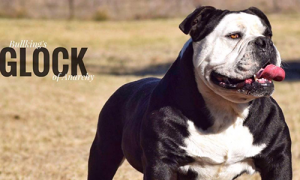 The Olde English Bulldogge is a breed that has gained a reputation for its remarkable appearance and impressive physical capabilities. This medium-sized dog has a muscular physique, great strength, stability, and athleticism, making it an excellent guard dog and loyal companion. In this article, we will delve deeper into the characteristics of the Olde English Bulldogge, including its coat and color, skull, muzzle, and jaw, eyes and ears, body, and chest.
The Olde English Bulldogge is a breed that has gained a reputation for its remarkable appearance and impressive physical capabilities. This medium-sized dog has a muscular physique, great strength, stability, and athleticism, making it an excellent guard dog and loyal companion. In this article, we will delve deeper into the characteristics of the Olde English Bulldogge, including its coat and color, skull, muzzle, and jaw, eyes and ears, body, and chest.
History of the Olde English Bulldogge
The Olde English Bulldogge is a breed that was created in the United States by crossing different breeds of bulldogs. The breeding process aimed to recreate the original English Bulldog from the 17th century before it became extinct due to selective breeding. The Olde English Bulldogge was developed to be a working breed, used for tasks such as catching and holding livestock and as a guard dog. Despite their history as bull-baiters, Olde English Bulldogges are known for their gentle and loyal nature, making them excellent family pets.
Learn More
Coat and Color
The Olde English Bulldogge has a short, close, and shiny coat of medium density. The coat comes in a variety of colors, including brindle of red, gray, fawn, or black, either solid or pied (with white). Solid white, fawn, red, or black colors are also possible. Recently, breeders have developed other colors such as chocolate, blue, and lilac. It is important to note that breeders should not prioritize color over the breed’s physical and temperamental characteristics.
Skull, Muzzle, and Jaw
The breed’s skull is large and well-proportioned to the dog’s muscular body, with a defined furrow from the stop to the occiput. A narrow skull and domed forehead are faults. The muzzle is square, wide, and deep, with a definite layback. The lower jawbone is moderately curved from front to back. Nostrils are wide, with a line running vertically between them from the tip of the nose down to the bottom of the upper lip. The nose is large and broad in relation to the width of the muzzle, and typically black except for chocolate and lilac where the nose is liver-colored. A well-defined jawline gives the Olde English Bulldogge an impressive and fierce look.
Eyes and Ears
The Olde English Bulldogge’s medium-sized, almond-shaped eyes are dark to light brown, with black pigmented eye rims. They are set wide and low, level with the top of the muzzle. Ears are small, rose, button, or tulip, with rose being the preferred type. They are set high, wide, and to the back outer edge of the skull.
Body and Chest
The Olde English Bulldogge’s neck is medium-length, wide, and slightly arched. When viewed from the side, the body is sturdy, powerful, and slightly rectangular in shape. The chest is wide and deep, giving the breed the necessary lung capacity for endurance activities.
Health Concerns
Like all breeds, the Olde English Bulldogge is susceptible to certain health issues. Breeders should screen for hip dysplasia, elbow dysplasia, and eye problems such as cherry eye and entropion. Olde English Bulldogges are also prone to allergies, skin infections, and breathing difficulties due to their brachycephalic facial structure. Prospective owners should research and be prepared to address these potential health issues to ensure the dog’s well-being.
Training and Exercise
Olde English Bulldogges are intelligent and eager to please, making them trainable dogs. Early socialization and training are important to prevent aggressive behavior towards other animals and strangers. Positive reinforcement techniques, such as reward-based training, work well with this breed.
The Olde English Bulldogge is a strong and athletic breed that requires regular exercise to maintain good health. Daily walks and playtime in the yard or park are recommended. They also enjoy activities such as swimming and hiking, making them suitable companions for active owners.
Learn More About the Olde English Bulldogge
For additional information about the Olde English Bulldogge or any puppies we may have available, please contact us.